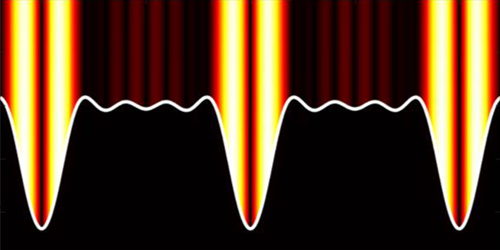Metallic Gratings Produce a Strong Surprise
When light and matter interact, quasiparticles called polaritons can form. Polaritons can change a material’s chemical reactivity or its electronic properties, but the details behind how those changes occur remain unknown. A new finding by Rakesh Arul and colleagues at the University of Cambridge could help change that [1, 2]. The team has uncovered an interaction regime where the light–matter coupling strength significantly exceeds that seen in previous experiments. Arul says that the discovery could improve researchers’ understanding of how polaritons induce material changes and could allow the exploration of a wider range of these quasiparticles.
Light–matter coupling experiments are typically performed using molecules trapped in an optical cavity. Researchers have explored the coupling of such systems to visible and microwave radiation, but probing the wavelengths in between has been tricky because of difficulties in detecting polaritons created using infrared light. Midinfrared wavelengths are interesting because they correspond to the frequencies of molecular vibrations, which can control a material’s optoelectronic properties.
To study this regime, Arul and his colleagues developed a technique to shift the wavelengths of midinfrared polaritons to the visible range, where detectors can better pick them up. Rather than molecules in a cavity, they coupled light to molecules atop a metallic grating. When irradiated with a visible laser beam, polaritons generated by the infrared radiation imprinted a signal on the scattered visible light, allowing polariton detection.
Using their technique, the team found a light–matter coupling strength at specific locations that was 350% higher than the average for the whole system. Researchers have been exploring the interaction of light with metallic gratings since the time of Lord Rayleigh, Arul says. “The system is still delivering surprises.”
–Katherine Wright
Katherine Wright is the Deputy Editor of Physics Magazine.
References
- R. Arul et al., “Raman probing the local ultrastrong coupling of vibrational plasmon polaritons on metallic gratings,” Phys. Rev. Lett. 131, 126902 (2023).
- M. S. Rider et al., “Theory of strong coupling between molecules and surface plasmons on a grating,” Nanophotonics 11, 3695 (2022).




